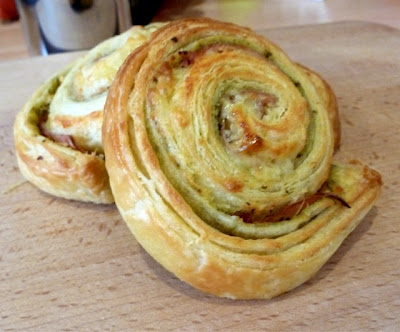Parsnip, Ginger & Orange Muffins
 Every Saturday, in the east end of London up near
Hackney, a generally quiet street becomes completely jammed with people for the
Broadway Market. There are all types of
stalls here including fresh produce, meat and fish as well as prepared meals
from Ghana and a variety of bakery stalls.
Every Saturday, in the east end of London up near
Hackney, a generally quiet street becomes completely jammed with people for the
Broadway Market. There are all types of
stalls here including fresh produce, meat and fish as well as prepared meals
from Ghana and a variety of bakery stalls.
The Fiendish & Goode stall sells all kind of small
cakes and we were taken by the parsnip & ginger cake. I'm a sucker for using vegetables in cakes,
having made my students make butternut squash scones, beetroot & chocolate
muffins, and carrot & sweet potato cakes, but I had never heard of or used
parsnip before, so this gave me an idea to try.
After a variety of trials, I finalised the recipe for
a photo shoot at the completion of the Food Styling course I completed at Leith’s
School of Food & Wine, so many thanks go to Stuart Ovenden for the lovely
photo and the training & advice given to us by Jennifer Joyce & Sarah
Cook.
Mini Parsnip, Ginger & Orange Cakes
2 eggs
120g light soft brown sugar
175ml oil
50g unsweetened plain yoghurt
130g plain flour
1/2 tsp bicarbonate of soda (baking soda)
2 tsp ground ginger
180g grated parsnip (about 2 large parsnips)
80g chopped stem ginger (in syrup)
Zest of 1 orange
Cream cheese icing
50g softened butter
100g cream cheese (e.g. Philadelphia)
300g icing sugar
1 tsp orange juice
Glace orange peel (for decoration)
1 orange
1 cup water
1 cup white granulated or caster sugar
Directions
1.
Heat oven to 180C/160C fan.
2.
Using an electric mixer, beat eggs and
sugar until creamy and pale.
3.
Combine the oil and yoghurt and beat into
egg mixture, slowly pouring in a steady stream.
4.
Sift the dry ingredients and add to the
mixture (including the wholemeal bran from the sieve) and mix well.
5.
Add the grated parsnip and chopped stem
ginger and stir to combine, the mixture should be thick and tacky.
6.
Lightly spray a 12 hole mini sandwich tin
with cake release spray (or a muffin tin) and share the mixture evenly between
the 12 holes (each hole should be about 3/4 full).
7.
Bake in oven for 35 minutes until golden
brown and spring back when lightly pressed.
8.
Allow to stand for 5 minutes before
turning out of the muffin tin. Cool
completely then ice with cream cheese icing.
Cream cheese icing
1.
Beat the butter and cream cheese together
until smooth.
2.
Beat in the icing sugar (adding small
amounts at a time to avoid creating an icing sugar cloud) and the orange juice.
3.
Ice cakes when completely cool &
decorate with glace orange peel (if desired).
Glace orange peel
1.
Carefully remove the orange skin and cut most
of the white pith from the skin before cutting into fine strips (using a zester
is too fine).
2.
Place the orange peel into a small saucepan,
cover with water and simmer for 20 minutes, then drain.
3.
Put the water & sugar into the
saucepan and heat over a medium heat to dissolve the sugar and then return the
orange peel to the saucepan and simmer for another 20-30 minutes until slightly
syrupy.
.jpg)
.jpg)













